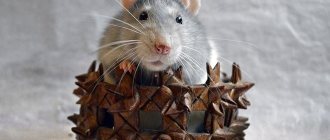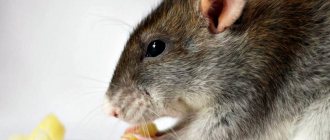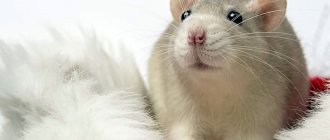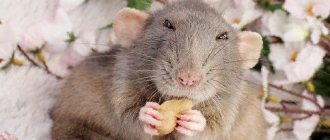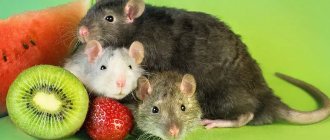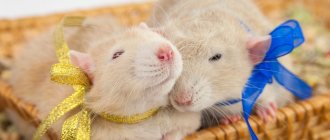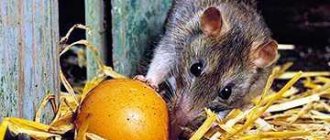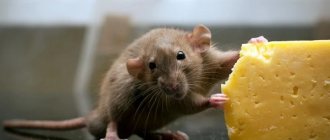Types of decorative rats
There are different breeds of decorative rats. According to the type of wool they are divided into:
- standard, with short and smooth pile;
- rexes with mustaches and wavy fur;
- satin - with shiny silky fur;
- sphinxes are naked rats;
- Dumbo - individuals are distinguished by round, low-set ears, reminiscent of Mickey Mouse.
Animal colors are divided into subspecies:
- homogeneous: there are pure black, white, chocolate, blue, albino and others;
- heterogeneous: rats have Siamese, Himalayan, sable, silver and other colors;
- variegated: composed of several colors.
Which rat to choose?
Thanks to selection work, decorative rodents have a wide variety of colors. The efforts of rat breeders are aimed at developing and consolidating new distinctive features and characteristics.
White rat
These are albinos who have lost their coloring pigment as a result of a genetic failure. The white rat is not found in nature, since it does not survive either in a pack (its relatives simply destroy it) or alone (a pack animal is not adapted to this). However, the rodent is invariably in demand because of its beautiful white coat and ruby eyes.
Some sellers offer specimens in pink, green, bright blue and other unusual shades. The secret of the “rare” coloring is simple: a dye is regularly mixed into the rodent’s food, which changes the color of the skin. Over time, the dye will be eliminated from the body, and the coat will again become snow-white. The buyer will be annoyed, and the animal may show symptoms of poisoning.
Dumbo
Due to the large and rounded or slightly pointed ears, sitting below the usual level, the rat resembles the baby elephant Dumbo from the Disney cartoon of the same name. This is a distinctive feature of the breed.
The fur can be of any color; there may be spots on it, scattered in any order.
This agile tame rat quickly becomes a favorite of many owners, who value it for its devotion to its owner and easy-going nature.
Blue
“Aristocrat” is what experts call the blue rat. It is highly prized for its unique bluish coat. The guard hairs of the coat are actually light gray along their entire length. The unusual color of the skin is given by the bluish undercoat.
The rodent's paws are the same shade as the undercoat. And the belly can be white, gray or silver.
Rex
The animals have tousled, rather stiff fur. The born baby is covered with curls, its fur resembles that of a sheep. It is soft to the touch, as if plush. As the baby grows, the color of the coat is constantly changing.
Adults have a wavy hair structure. They even retain curls on their back and sides.
Sphinxes
This hairless rat is hairless. Purebred individuals retain remnants of delicate undercoat on the ankles and wrists, in the groin and around the eyes. This is a rare and quite expensive breed.
Sphynxes can be kept by people who are allergic to animal fur. Unfortunately, naked rodents live less than other rats. An animal unprotected by fur is more susceptible to colds.
Anurans
The pear-shaped body of the animal ends with a small tubercle instead of a tail. The coat can be of any color, it is smooth or curly, short or long, or the rodent is completely hairless.
The breed appeared as a result of the consolidation of a mutation. Breeding this species is a rather lengthy process, since crossing tailless rats does not produce healthy offspring. And the cubs of tailless and tailed individuals do not always inherit the required trait.
Animals are extremely difficult to acquire. Fraudsters pass off specimens with a tail after docking as tailless rodents. A real representative of the breed can only be purchased in nurseries.
Odd-eyed
This species is characterized by eyes of different colors. As a rule, one of them is pink, and the second is black, red or dark ruby. But other combinations are also possible.
This gene mutation can appear in any breed, but in itself it is very rare. It can only be reproduced after several matings.
This domestic rat is more expensive than other rodent breeds. The more different the eyes are from each other, the higher the price.
Summary table of prices by place of purchase and breed of rats
Prices for rodents are given for Moscow, Ukraine and some CIS countries. In other regions of Russia, the cost of a rat is significantly lower (average figures are given).
| Place of purchase | Russia, cost in rubles. | Moscow, cost in rubles. | Ukraine, cost in UAH. | Belarus, price in Bel. rub. | Kazakhstan, cost in tenge. |
| Standard | |||||
| Private seller | 100 | 300 | 10 | 5 | 400 |
| Shop | 200 | 500 | 25 | 7 | 700 |
| Nursery | 300 | 700 | 60 | 10 | 100 |
| Albino (white) | |||||
| Private seller | 150 | 350 | 25 | 5 | — |
| Shop | 250 | 600 | 70 | 7 | — |
| Nursery | 500 | 1000 | 150 | 10 | — |
| Standard (blue) | |||||
| Private seller | 250 | 350 | 25 | 7 | — |
| Shop | 500 | 700 | 50 | 10 | — |
| Nursery | 1000 | 1200 | 100 | 115 | — |
| Dumbo | |||||
| Private seller | 250 | 500 | 30 | 7 | — |
| Shop | 500 | 700 | 50 | 10 | — |
| Nursery | 1000 | 1000 | 150 | 15 | — |
| Rex | |||||
| Private seller | 200 | 500 | 20 | 12 | — |
| Shop | 250 | 700 | 25 | 15 | — |
| Nursery | 1100 | 1600 | 150 | 17 | — |
| Sphinx | |||||
| Private seller | 200 | 300 | 20 | 12 | — |
| Shop | 300 | 1000 | 30 | 15 | — |
| Nursery | 1500 | 2000 | 150 | 20 | — |
| Tailless | |||||
| Private seller | 500 | 1000 | 25 | 10 | — |
| Shop | 700 | 1500 | 40 | 15 | — |
| Nursery | 2000 | 3000 | 200 | 30 | — |
Keeping decorative rats
Domestic decorative rats are rodents; they are cared for and kept in metal cages, because they are the strongest and most durable. It is better not to keep animals in plastic and wooden structures. It is also not recommended to place them in aquariums - they are difficult to clean, and the animals jump to a height of 40-50 cm and can escape. The house is installed in a place where there is no direct sunlight and draft, from which a rat can contract pneumonia. There is no need to place a home near the battery - dry air is harmful to animals. Optimum temperature +18-20°C.
For a decorative rat, the cage should have a size of 60x40x30 (for growth); often the house has two floors. Inside the home you need to install:
- a plastic tray with filler (preferably dry wood granules. Small sawdust can cause allergies in rats by getting into their eyes and nose. Newsprint contains harmful substances and is not suitable for use as bedding);
- stairs and tunnels, a wheel (animals love to play);
- plastic house for privacy;
- mineral stone for rodents (they sharpen their teeth);
- drinking bowl;
- 1-2 bowls;
- a cloth for sleeping or a hammock.
Keeping a rodent - what is necessary?
The animal is purchased, but the expenses are not limited to this. A decorative rat should get a home where it will be cozy and comfortable. To house a pet you need:
- The cage must be spacious enough and designed specifically for rodents. Dimensions, material and number of floors determine the range of prices - from 500 rubles to 13 thousand.
- Various toys and exercise equipment for the development of a pet, a house or other shelter. You can buy them (120-240 rubles) or make them yourself.
- Feeder. You can buy it in a store or find a bowl suitable for the animal at home.
- Drinking bowl. A convenient automatic one will cost from 130 to 500 rubles.
- Litter and litter. They need to be changed quite often. The price per kilogram reaches 50 rubles.
Food for the animal
The rat prefers plant foods, so regular food from the master's table does not suit it. The owner can independently choose a menu for the pet, which is quite troublesome because it takes time and requires knowledge. But if he has a desire to cook for his pet and takes into account the advice of experts, then this is the least expensive option.
Another solution to the issue of rodent nutrition is the use of purchased food. Their prices range from 100 (economy class) to 1000 rubles (super-premium).
Vaccinations and other expenses
It is difficult to determine the exact amount for the procedures necessary to maintain the health of the rodent. In the capital's veterinary clinics, an initial examination costs between 800 and 2,000 rubles, the cost of operations reaches 3,000 rubles, and sterilization - from 1,500 rubles. The situation in other cities is no simpler, since it is difficult to find a specialized specialist there.
Your pet probably won't need veterinary care any time soon. But if the animal was purchased at the market, it must be vaccinated against rabies. The cost of vaccination is determined by the drug used and the prices for the services of the veterinary hospital. It is 1000-1300 rubles. The cost of annual revaccination of the animal should also be included in the budget.
How to care for a decorative rat?
If decorative rats live in the house, care and maintenance of them include indispensable cleaning of the cage. Drinkers and bowls need to be washed daily, remove soiled or wet bedding, food debris, and change the filler in the tray. The cage and all household items must be systematically disinfected. If you carefully care for your decorative rat, the smell from it will be almost invisible. The animals are unpretentious and easily adapt to any environmental conditions. You can sometimes let them out for a walk, but you need to keep an eye on the pet so that it doesn’t chew on valuables.
Is it possible to bathe decorative rats?
Decorative domestic rats are neat and clean animals; keeping babies requires mandatory bathing. The procedure is carried out if the animal itches or has an unpleasant odor. Shampoo from a pet store will help deal with it. For bathing, prepare a container with heated water. They put the animal in it and wash it with their hands. In this case, the rodent may scratch and bite, but some people like this procedure. When bathing, you need to pay attention so that water does not get into the rat’s ears and nose. After the procedure is completed, the animal is dried with a towel.
Dumbo rats are the TOP of the best rats!
Dumbo rats are the TOP of the best rats! Domestic Dumbo rats are smooth-haired, a breed of Dumbo-eared rats bred in California in 1990. The cute and friendly Dumbo rats quickly gained recognition among children and adults, so more and more often Dumbo rats are kept as a pet. You can see what breeds and types of rats exist in nature on our website - krysa.house by visiting the Questions and Answers section.
buy a Dumbo rat (purebred) or choose and buy baby rats of different colors on the website of our nursery - krysa.house. to check availability and buy a domestic rat Dumbo quickly with home delivery, use the WhatsApp form and write to the breeder a question.
Decorative rats Dumbo are so similar to the cartoon hero the baby elephant Dumbo with huge ears that children simply adore these cutest animals and dream of receiving a pet rat Dumbo as a gift.
In addition to its charming appearance, the Dumbo rat breed is very smart, playful, and easily learns commands and simple skills for a treat, so you and your children will never be bored with your pet Dumbo rats. You can buy a Dumbo rat with good breed characteristics in our nursery.
Photos of rats and baby rats. Choose and buy Dumbo the rat. Nursery – krysa.house
What to feed a decorative rat at home?
Care and maintenance of a rodent have its own nuances in nutrition. Although animals are unpretentious in food, their diet should contain as little fat as possible. Adults are fed 2 times a day, babies - 4 times. They also need clean and fresh water. What to feed a decorative rat at home:
- Grain base (wheat, oats, barley, corn, millet). High-quality balanced mixtures are sold in pet stores.
- Vegetables, fruits: white cabbage, carrots, bananas, cucumbers, apples, boiled potatoes, pumpkin, eggplants, grapes.
- Protein food (given once a week): a piece of boiled meat, cottage cheese, cheese, egg.
- Chicken bones: animals love to sharpen their teeth with them.
- In autumn and winter, it is recommended to give pets ready-made vitamins from a pet store.
Decorative rats - care and maintenance: what should not be given as food:
- chocolate, sweets, candies;
- raw beans or beans;
- smoked sausage;
- raw potatoes;
- chips;
- soda and sweet drinks;
- Brussels sprouts and red cabbage.
What grass can be given to decorative rats?
Greens should be present in the daily diet of rodents. What do decorative rats eat from grasses:
- dill;
- dandelion;
- parsley;
- cilantro;
- plantain;
- radish tops.
Final cost table depending on the place of purchase
To make it easier to determine the price of a rat depending on the place of purchase and breed, you can use a special table:
| Breed | Cost, rub. | |||
| From hand | At the poultry market | At the pet store | From professional breeders | |
| Standard | 200-300 | 400-500 | 600-700 | 800-3000 |
| Fuzz | 700-800 | 900-1000 | 1200-1400 | 1500-2000 |
| Sphinx | 400-500 | 600-800 | 800-1000 | 1200-2000 |
| Blue standard | 350-500 | 500-700 | 700-900 | 900-1200 |
| Dumbo | 500-600 | 700-800 | 900-1000 | 1000-1500 |
| Rex | 600-700 | 800-900 | 900-1000 | 1100-1600 |
| Tailless | 1000-1300 | 1300-1500 | 1500-2500 | 2500-3000 |
It is worth noting that the table shows only approximate prices for rats of various breeds. Prices for fluffies may vary slightly at different retail outlets.
Decorative rats - diseases
A healthy animal is always active, it has clear eyes and shiny fur. There should be no red spots around the rodent's eyes, nose and ears. Knowing what a decorative rat looks like when properly cared for in a healthy state, if abnormalities are detected, you should consult a doctor. Rodent diseases:
- Excessive tooth growth. Occurs due to insufficient grinding and using only soft food - a veterinarian can help.
- Mycoplasmosis. A bacterial disease, infection occurs through the air, leading to pneumonia. It is almost impossible to save the animal.
- Abscesses. Abscesses appear on the skin, the doctor opens them, treats them, and administers the necessary medications.
- Tumors. They can be benign or malignant; the decision to remove them is made by the veterinarian.
- External parasites are mites. Appear from an excess of protein foods. It is necessary to remove seeds, nuts, meat from the diet, and clean the home daily for 1-2 weeks.
Maintaining a sanitary regime and ensuring a balanced diet are the main conditions for proper maintenance and care of the animal. Some infectious and parasitic diseases are also dangerous for humans, so you need to monitor the behavior and appearance of the animals and maintain personal hygiene. If your pet has lost its appetite, become less active, or looks unusual, it is important to contact a veterinarian.
How to tame a decorative rat?
Decorative rats have pros and cons in their character. The first include openness to communication and intelligence. As soon as a little rat appears at home, he is immediately given a name and addressed to him when food is poured in. After three days, the rodent begins to respond to the nickname and recognize the owner. Then you can gradually accustom him to holding hands. After the animal finally gets used to its owner, it is released to walk around the apartment. The disadvantage of a pet is the desire to chew on something - this must be controlled.
Other varieties
Pasyuk
This is a fairly large rodent, weighing 250-600 grams. Unlike the domesticated form, the pasyuk has a convex forehead and well-defined brow ridges. The pasyuk's tail is thick and its length is shorter than the body. The ears are relatively small. Pasyuk is a homogeneous standard agouti.
Rat Pasyuk
Pasyukov can be kept at home, including together with a domesticated rat. Some nurseries infuse the blood of wild gray rats into domestic animals or breed only pasyuki.
Pasyuk retained most of his natural instincts. He easily accepts new experiences, thinks quickly and survives in the wild.
Tailless rat (Manx)
Manx is the result of a complex mutation. Many unions of rat lovers are against the breeding of this species. Accordingly, it is unrecognized. Tailless Manx are disabled by definition, as they have lost their balance beam. In addition, the tail cools the animal at high temperatures.
As a result of this mutation, the musculoskeletal system and organs of the excretory system are affected. Often the cubs die at an early age or a little later.
All varieties are kept under the same conditions. The features of caring for each rat are also the same. Animals are kept in spacious cages and terrariums, in a warm and dry place, without drafts. The rats are provided with quality food and water, a running wheel and toys.
Based on the description of the species, rodents are given a specific name. For example, Albino Self Standard Velveteen means that the rat is a standard albino with a solid color and corduroy coat type. BE Siamese Self Dumbo Rex – Dumbo with black eyes, Siamese color with curly coat type.
Decorative rat - reproduction
Breeding of decorative rats is carried out using a pair of opposite-sex individuals aged 6 months. Girls weigh 200-400 g, they are nimble and neat. Boys - 450-600 g each, mostly clumsy and sloppy. The female's estrus repeats every 10 days. Mating is carried out for 1-4 hours in any territory - it does not matter with a girl or a boy. The female's pregnancy lasts 21 days, during which time she needs to eat more fruits and vegetables. Before giving birth, the expectant mother builds a nest - she drags out various materials (rags, toilet paper). The female gives birth to up to 8 rat pups weighing 5-7 g.
If a couple lives together, then at the time of birth the male must be separated so that he does not show aggression towards the babies. It is important for the mother in labor to have access to clean water so that she does not eat her offspring. The mother feeds the newborns for a month; from the third week of life they begin to try adult food. Babies' fur grows by 8-10 days, and their eyes open between 12 and 16 days. At the age of 1.5 months, the animals become completely independent and must be separated by gender or sold. After 12-18 months of life, females can no longer have offspring.
Where is the best place to buy a rat?
When purchasing a decorative rat, future owners inevitably face the question of where is the best place to buy a pet. Experienced breeders recommend not to succumb to the temptation of purchasing an animal from your own hands at the cheapest price. It is better to pay the required amount and get a healthy rat with a good pedigree.
As a last resort, you can go shopping at a pet store. Even in the event of an unplanned pregnancy of a female, the rat pups can always be given away. But you won’t have to spend additional money on constant treatment of many diseases in expensive veterinary clinics. Moreover, most specialized stores have a good price/quality ratio.
Training of decorative rats
There are many tricks that complement the natural habits of rodents and will bring pleasure to the owners. To do this, you will need a treat - a piece of meat, a pumpkin seed. How to train a decorative rat:
- Return to the cage. After the animal has taken root, it can be released for a walk around the apartment. It’s easy to return the animal: at the same time you need to sprinkle food, knock the bowl on the floor and call your pet - he will come running.
- “Sit” or “serve.” You need to hold the treat over the animal’s head and say the command. The rat will learn that it gets a treat after it stands on its hind legs and will follow the order to “sit” every time, even without a treat.
- Run in circles. You can move the treat along a trajectory and give it to the animal after it completes the trick. Also, with the help of treats, it is easy to teach a rat to run up stairs.
